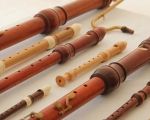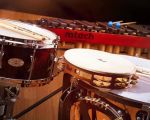Best Woodwind Instruments for Concert Bands in 2025
Apr 19, 2025
Choosing the Best Woodwind Instruments for Concert Bands
When I first joined my high school concert band, I had no idea how much the woodwind section would shape my musical journey. It wasn’t just about playing an instrument – it was about blending in with the harmony of the group, contributing to the overall sound, and learning how each woodwind instrument added its own unique voice. Over the years, I’ve had the opportunity to play alongside various woodwinds, from the grand sounds of the saxophone to the smooth melodies of the clarinet.
If you're considering joining a concert band, or perhaps you're looking to upgrade your instrument, knowing which woodwind instruments are best suited for different musical pieces is essential. In this article, I’ll guide you through some of the best woodwind instruments for concert bands, touching on their individual qualities, how they contribute to an ensemble, and which one might be the right choice for you.
1. Why Woodwind Instruments are Essential in Concert Bands
In concert bands, woodwind instruments play a vital role in adding richness, texture, and melody to the music. These instruments are made from wood or metal and produce sound through a reed, though there are exceptions like the flute, which creates sound through air blown across a hole. The woodwind section typically includes instruments like the flute, clarinet, saxophone, and oboe, each with its own unique characteristics.
I vividly remember the first concert I played in, where the woodwind section was tasked with carrying the melody in several pieces. It was amazing to hear how the flute would soar over the brass section, while the clarinet added depth and warmth. This balance between the different instruments is what makes woodwind sections so essential in concert bands.
2. Top Woodwind Instruments for Concert Bands
After years of performing and studying various woodwind instruments, here are some of the best choices for concert bands based on their versatility, sound, and contribution to the ensemble:
1. Flute
The flute is one of the most popular woodwind instruments in concert bands, known for its bright, clear tone and ability to carry the melody. Made from silver, gold, or platinum, flutes are used in both orchestras and concert bands and can be found in a variety of musical styles, from classical to contemporary.
One of the reasons the flute is so essential in concert bands is its ability to cut through the sound of other instruments. Whether performing delicate passages or playing fast runs, the flute shines with its agility and range. In one of the concert band pieces I performed, the flute played the main theme while the brass section provided harmony, and the combination was simply breathtaking.
2. Clarinet
The clarinet is another staple of concert bands, known for its smooth, warm tone and incredible range. It is often used in both melodic and harmonic roles and is versatile enough to fit into a wide variety of musical genres. What makes the clarinet stand out is its ability to play both high and low notes with ease, making it one of the most flexible instruments in the woodwind family.
In my experience, the clarinet often serves as the bridge between the woodwind and brass sections, offering harmonies that enhance the overall sound of the band. Whether playing a solo or blending in with the ensemble, the clarinet’s sound is both rich and expressive. I remember being impressed with the clarinet section during one of our concerts, where they added such a beautiful, mellow tone to the overall arrangement.
3. Saxophone
The saxophone is a woodwind instrument made of brass but is classified as a woodwind due to the reed mechanism it uses. It has a rich, warm tone and comes in several different sizes, including alto, tenor, baritone, and soprano. The saxophone is a prominent feature in jazz bands, but it also plays an important role in concert bands, adding a bit of flair and brass-like sound to the woodwind section.
Saxophones are often used to add depth to the woodwind section and provide a smooth, almost velvety sound that contrasts beautifully with the sharper tones of the flute or clarinet. I’ve had many performances where the saxophone provided the perfect lead into a dramatic climax or added a layer of sophistication to the music. The blend of saxophones with the rest of the woodwinds creates a full and engaging sound that fills the room.
4. Oboe
The oboe is known for its distinct, reedy sound that adds an expressive, lyrical quality to any concert band. While it’s not as commonly featured in larger sections, its piercing sound is highly valued for its emotional depth and beauty. The oboe’s slightly nasal tone can be incredibly striking, and its ability to convey both delicacy and power makes it indispensable in many classical concert band arrangements.
I remember playing a piece where the oboe led the melody for a soft, heart-wrenching section of music. Its sound was almost haunting and perfectly complemented the other woodwinds, creating a sense of unity within the band. The oboe truly is one of the most emotive instruments, capable of conveying a wide range of emotions.
5. Bassoon
The bassoon is a larger and lower-pitched woodwind instrument, known for its deep, rich tone that provides the foundation for the woodwind section. In a concert band, the bassoon often plays harmony, but it can also be used for solo parts when composers want a darker, more resonant sound.
While the bassoon is less common in some smaller concert bands, it provides an essential counterbalance to the higher-pitched instruments like the flute or clarinet. In one of our concert band performances, the bassoon was able to give the piece a weighty, grounded feel, providing a contrast to the light, soaring melodies of the other instruments.
3. Choosing the Right Woodwind Instrument for Your Concert Band
If you're a beginner or intermediate player, choosing the right woodwind instrument for your concert band depends on a few factors:
Sound Preference: Do you prefer a bright, clear tone (flute), a warm, rich sound (clarinet), or something deeper and more resonant (bassoon)? Knowing what kind of sound you want to produce will help you choose the instrument that fits your musical goals.
Physical Considerations: Some woodwind instruments, like the oboe and bassoon, require more physical strength to play due to their size and reed size. It’s essential to consider comfort and personal physical capability when selecting an instrument.
Ensemble Role: Different instruments play different roles in a concert band. If you want to take center stage with melodic parts, instruments like the flute or clarinet may be a good choice. If you prefer supporting roles or adding depth to the ensemble, instruments like the bassoon or saxophone might be more suitable.
4. Conclusion
The woodwind section of a concert band is one of the most diverse and essential parts of the ensemble. Each instrument within this section offers unique characteristics that contribute to the overall sound, from the agile flute to the rich bassoon. As someone who has played multiple woodwind instruments, I can personally attest to the importance of selecting the right instrument for both your personal goals and the needs of the band.
If you’re looking for more advice on choosing the right woodwind instrument for your concert band, or need help finding the best instruments on the market, visit Beat Trigger for expert recommendations and insights. Happy playing!







